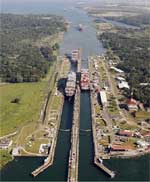Growth in world trade spurs demand for financing of ships and terminals.
Sharp growth in the size of cargo ships has prompted expansion of the Panama canal.
 |
|
Sharp growth in the size of cargo ships has prompted expansion of the Panama canal. |
The global shipping business is sustaining its strong forward momentum, thanks to the fast growth of world trade. Shipowners are making good profits and are placing orders for bigger and more-efficient ocean-going vessels. The shipping industry carries more than 90% of the world’s traded goods by volume, and it has been booming since the rise of China and India as major economic powers with seemingly insatiable demand for raw materials.
The shipping banks that finance the fleet expansion needed to keep world trade growing are also reporting strong gains in income and higher sales of capital-market products, as well as an increase in new listings of shipping companies. Financing of the big super-post-Panamax class of ships capable of carrying 13,100 20-foot containers, or “boxes,” is adding to the already considerable need for financing the fast growth in the dry-bulk shipping fleet, which carries coal, iron ore and steel, as well as wheat and foodstuffs. Just a few years ago, the biggest container ships could carry at most 9,000 boxes, but the newer and bigger ships are more efficient for high-volume routes, such as between the United States and China.
Meanwhile, very large crude carriers (VLCCs) and specialized liquefied natural gas (LNG) carriers are being built as fast as the world’s shipyards can keep up with the orders. Shipyards in South Korea, the world’s biggest shipbuilding nation, received record orders last year, despite the fact that ship prices have more than doubled in the past four years. High oil prices are also boosting demand for oilrig financing and FPSOs, or floating production, storage and offloading vessels.
From syndicated shipping loans, to debt, equity and derivatives, the market for shipping finance is expanding rapidly. The world’s first jumbo ship Pfandbrief with a rating was issued by Germany-based HSH Nordbank on January 8, 2008, opening up a major new source of funding using ship loans as collateral. HSH Nordbank, Deutsche Bank and HSBC were joint lead managers of the €1 billion ship Pfandbrief, introducing a new asset class in the covered bond market.
HSH Nordbank is a fairly new name in the market, as it is the result of the merger in 2003 between Hamburgische Landesbank and Landesbank Schleswig-Holstein, known as LB Kiel. However, both predecessor banks were founded in the early 1900s and are long-established names in the shipping finance market.
HSH Nordbank, which is based in Hamburg and Kiel, two cities with prominent port operations, is the world’s largest provider of ship finance. At the end of the third quarter of 2007, its ship-finance book totaled €26 billion of outstanding loans, plus €11 billion of committed facilities, or a grand total of €37 billion, equivalent to more than $50 billion, up from $30 billion a year earlier.
 |
|
Femers: Future jumbo ship Pfandbriefs may be denominated in dollars. |
The bank has a well-diversified ship-loan portfolio with regard to vessel types and geographical spread of its borrower customers. Besides Germany, HSH Nordbank has a strong presence in Greece, Scandinavia and southern Europe, including Turkey. It is also active in the United States and Asia. The bank’s portfolio of ocean-going vessels has a low average age, with 60% of the fleet younger than five years old.
Vessel collateral plays a dominant role in HSH Nordbank’s risk management. Ships have an average life expectancy of about 25 years and can be employed worldwide. The typical financing structure is long term, usually 10 to 14 years, secured by a mortgage on the vessel.
The vessels are insured against all imaginable risks. Hull and machinery insurance for a minimum of 120% of the outstanding loan amount covers perils of the sea, such as loss or damage to the ship. In addition, disbursements insurance is taken out to guard against a total loss of the vessel. War risks insurance covers damages or loss resulting from acts of war, terrorism, piracy or confiscation.
Since HSH Nordbank is a universal bank, generally all of its assets serve as collateral for investors. However, for the purpose of issuing ship Pfandbriefs, certain eligible assets are “ring-fenced” and transferred into a separate cover pool, which is regulated by German law. Ship cover pool assets serve as collateral exclusively for holders of ship Pfandbrief bonds in the unlikely event of the issuer’s default, says Guenter Femers, head of debt investor relations, treasury, at HSH Nordbank.
No Transfer of Risk
The German Pfandbrief is the prototype of covered bonds and has a long tradition spanning 235 years without a single default, Femers says. Although ship loans provide the collateral for the jumbo ship Pfandbrief, the issue should not be confused with securitizations, since there is no transfer of risk with the Pfandbrief, he says. “This is solely a refinancing tool, and the risk remains with the bank,” he explains. The assets used to collateralize the Pfandbrief remain on the balance sheet of the issuer.
 |
|
Irkly: Shipping companies are being more creative in arranging finance. |
Numerous changes to the legal and regulatory framework for banks in Germany came into force in 2005. The new German Pfandbrief Act supersedes all previously existing legislation governing Pfandbrief issuance. One major difference between Pfandbriefs and securitizations is that cover-pool assets and issuers are required to meet the highest legal standards under German law. Therefore, the ratings on Pfandbriefs generally are AAA, and the yields are relatively low compared with those on securitizations. Only loans secured by ship mortgages may be used as cover. Mortgage lending may not exceed the first 60% of the ship mortgage lending value. The maximum loan term is 15 years and may not extend beyond the period when a ship will be 20 years old.
“The holder of the Pfandbrief bond has recourse to [HSH Nordbank] as the issuer,” Femers says. “Only in the unlikely case of insolvency, the ring-fenced cover pool will be taken for the exclusive satisfaction of debt-service requirements of Pfandbrief bond investors, which makes this a very safe instrument,” he says.
HSH Nordbank offered the jumbo ship Pfandbrief for subscription on January 8 and closed the books in less than two hours, when it was three times oversubscribed. The issue size was fixed at €1 billion, a coupon of 4.25% and a two-year term. Moody’s Investors Service gave the ship-cover pool an AAA rating. Germany-based financial institutions acquired 70% of the issue, with the remainder sold to investors based in other European countries and in Asia.
In light of the success of the offering, HSH Nordbank likely will issue one or two annually in the future, Femers says. Future issues may be dollar denominated, he says, because the bank has a natural need for dollars, since shipping loans are largely dollar denominated. He notes that these issues could be targeted primarily to investors in the Middle East and Asia, particularly countries with large shipyards, such as China, South Korea, Japan and Vietnam.
Russians Try New Techniques
More and more Russian shipping companies are using new techniques to finance fleet renovation and expansion, says Marina Irkly, transport analyst at Moscow-based Veles Capital Investment. Syndicated loans are increasingly popular, she says. Primorsk Shipping (Prisco), the world’s third-largest tanker company, borrowed $375 million in May 2007 from a syndicate of 12 banks. BNP Paribas and Nordea acted as co-arrangers of the 10-year facility that will be used in part to finance the construction of four new tankers. “Ice class” vessels, including large-capacity tankers equipped for operation in freezing seas, make up the core of the company’s fleet.
“Shipping companies are working with several banks to renovate their fleets, since they need large sums of money that overshoot the capacity of a single lender,” Irkly says. A federal government program known as “Modernization of the Russian Transport System (2002-2010)” is also boosting shipping finance. “According to this program, 90% of all foreign trade cargo transported by shipping routes should be discharged in Russian ports, whereas 25% is now being handled by ports in neighboring countries,” she says.
The rapid growth in maritime trade means that huge sums are being spent on the development of port and terminal facilities, in addition to spending on ships. In the fast-growing Middle East region, for example, containerized imports are growing at about 18% annually and are straining the capacity of ports and handling equipment. Large-scale projects are being financed using Shariah-compliant structures. The Multilateral Investment Guarantee Agency (MIGA), a member of the World Bank Group, in January 2008 provided its first-ever guarantee for Shariah-compliant project financing. The $427 million guarantee will support investments in a new container facility in Djibouti. The terminal is being developed jointly with Dubai Ports World. Dubai Islamic Bank, Standard Chartered Bank and WestLB are the financing banks.
Bahrain-based Ahli United Bank and Arab Banking Corporation (ABC) closed the senior phase in February for a $480 million, 15-year syndicated debt facility for Damietta International Port on Egypt’s Mediterranean coast. The African Development Bank, Banque Misr and National Bank of Egypt joined in the lending facility.
A project to double the capacity of the Panama Canal, allowing post-Panamax-class ships to pass through its locks, was officially begun in September 2007. Slated to conclude by 2014, the project will cost an estimated $5.25 billion. It involves the construction of a third lane of traffic along the waterway using a new set of locks. The canal was transferred eight years ago from US to Panamanian operation.
Shippers traveling from the US Gulf Coast to Asia can save 10 days of time by using the Panama Canal. More than half of the containerized volume through the canal reflects traffic from Asia to the US East Coast. Growth on this route has rapidly increased demand for the waterway’s services, which are nearing maximum capacity.
China Adds to the Strain
The growth of China’s fleet is also creating demand for financing. Sinotrans Shipping raised $1.5 billion in its initial public offering in Hong Kong in September 2007 in the largest Chinese shipping IPO since 1999. BOC International and UBS arranged the share sale. Sinotrans Shipping is adding capacity to meet increasing demand to transport dry-bulk cargoes and to carry crude oil from the Middle East to China.
Daily charter rates for dry-bulk carriers doubled in 2007, although they have retreated in the early months of 2008 on worries about a slowing in global economic growth. With world trade growing at three times global output, however, demand for ships is expected to remain strong for the foreseeable future. With dry-bulk charter rates running at 250% to 300% of their 10-year average, they can be expected to edge lower over the next three years. It will take more new ships coming out of the world’s backlogged shipyards to cause any further reduction in charter rates. The supply and demand will take time to reach a balance in what has always been a cyclical industry.
Gordon Platt



